Treeshrew
| Treeshrews Middle Eocene – Recent
| |
|---|---|

| |
Tupaia sp.
| |
| Scientific classification | |
| Domain: | Eukaryota |
| Kingdom: | Animalia |
| Phylum: | Chordata |
| Class: | Mammalia |
| Grandorder: | Euarchonta |
| Order: | Scandentia Wagner, 1855 |
| Families | |
| |

| |
| Red: Ptilocercidae
| |
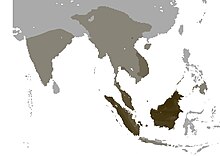
| |
| The distribution and density of treeshrew species. | |
The treeshrews (also called tree shrews or banxrings
Though called 'treeshrews', and despite having previously been classified in Insectivora, they are not true shrews, and not all species live in trees. They are omnivores; among other things, treeshrews eat fruit.
Treeshrews have a higher
but high ratios are not uncommon for animals weighing less than 1 kg (2 lb).Among orders of mammals, treeshrews are closely related to
Name
The name
Description
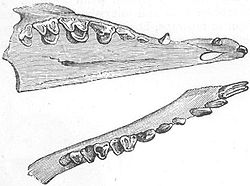

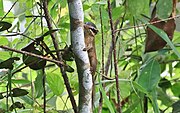

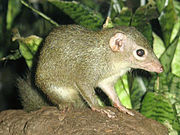
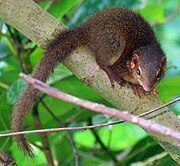


Treeshrews are slender animals with long tails and soft, greyish to reddish-brown fur. The terrestrial species tend to be larger than the arboreal forms, and to have larger claws, which they use for digging up insect prey. They have poorly developed canine teeth and unspecialised molars, with an overall dental formula of 2.1.3.33.1.3.3[8]
Treeshrews have good vision, which is binocular in the case of the more arboreal species.
Reproduction
Female treeshrews have a gestation period of 45–50 days and give birth to up to three young in nests lined with dry leaves inside tree hollows. The young are born blind and hairless, but are able to leave the nest after about a month. During this period, the mother provides relatively little maternal care, visiting her young only for a few minutes every other day to suckle them.
Treeshrews reach sexual maturity after around four months, and breed for much of the year, with no clear breeding season in most species.[8]
Behavior
Treeshrews live in small family groups, which defend their
They
Diet
Treeshrews are omnivorous, feeding on insects, small vertebrates, fruit, and seeds. Among other things, treeshrews eat Rafflesia fruit.
The pen-tailed treeshrew in Malaysia is able to consume large amounts of naturally fermented nectar from flower buds of the bertam palm
Treeshrews have also been observed intentionally eating foods high in capsaicin, a behavior unique among mammals other than humans. A single TRPV1 mutation reduces their pain response to capsaicinoids, which scientists believe is an evolutionary adaptation to be able to consume spicy foods in their natural habitats.[11]
Taxonomy
They make up the entire
.Treeshrews were moved from the order
| Euarchontoglires |
| ||||||||||||||||||||||||
Several other arrangements of these orders have been proposed in the past, and the above tree is only a well-favored proposal.
| Euarchontoglires |
| ||||||||||||||||||||||||||||||
Order Scandentia
The 23
- Family Tupaiidae
- Genus Anathana
- Madras treeshrew, A. ellioti
- Genus Dendrogale
- Bornean smooth-tailed treeshrew, D. melanura
- Northern smooth-tailed treeshrew, D. murina
- Genus Tupaia
- Northern treeshrew, T. belangeri
- Golden-bellied treeshrew, T. chrysogaster
- Bangka Island treeshrew, T. discolor
- Striped treeshrew, T. dorsalis
- Mindanao treeshrew, T. everetti
- Sumatran treeshrew, T. ferruginea
- Common treeshrew, T. glis
- Slender treeshrew, T. gracilis
- Javan treeshrew, T. hypochrysa
- Horsfield's treeshrew, T. javanica
- Long-footed treeshrew, T. longipes
- Pygmy treeshrew, T. minor
- Mountain treeshrew, T. montana
- Nicobar treeshrew, T. nicobarica
- Palawan treeshrew, T. palawanensis
- Painted treeshrew, T. picta
- Kalimantan treeshrew, T. salatana
- Ruddy treeshrew, T. splendidula
- Large treeshrew, T. tana
- Family Ptilocercidae
- Genus Ptilocercus
- Pen-tailed treeshrew, P. lowii
Fossil record
The fossil record of treeshrews is poor. The oldest putative treeshrew,
Named fossil species include Prodendrogale yunnanica, Prodendrogale engesseri, and Tupaia storchi from Yunnan, Tupaia miocenica from Thailand, Palaeotupaia sivalicus from India[22] and Ptilocercus kylin from Yunnan.[21]
References
- OCLC 62265494.
- ^ "Appendices | CITES". cites.org. Retrieved 2022-01-14.
- ^ Rines, George Edwin, ed. (1920). . Encyclopedia Americana.
- ^ "an article on Tupaia belangeri". The Genome Institute. Washington University. Archived from the original on 1 June 2010.
- S2CID 16910445. Retrieved 1 January 2012.
- ISBN 978-0-8018-5789-8.
- ^ Craig, John (1849). A new universal etymological technological, and pronouncing dictionary of the English Language.
- ^ ISBN 978-0-87196-871-5.
- ^ Moscowicz, Clara (2008). "Tiny tree shrew can drink you under the table". NBC News.
- PMID 18663222.)
{{cite journal}}: CS1 maint: multiple names: authors list (link - ^ "See Why Tree Shrews Are Only the Second Known Mammal to Seek Spicy Food". nationalgeographic.com. Archived from the original on August 27, 2018. Retrieved 2018-08-26.
- S2CID 12251814.
- ^ PMID 25311886.
- S2CID 38120449.
- PMID 2575767.
- PMID 24333622.
- PMID 27325836.
- PMID 23560065.
- PMID 17307271.
- ^ a b
Roberts, T.E.; Lanier, H.C.; Sargis, E.J.; Olson, L.E. (2011). "Molecular phylogeny of treeshrews (Mammalia: Scandentia) and the timescale of diversification in Southeast Asia". Molecular Phylogenetics and Evolution. 60 (3): 358–372. PMID 21565274.
- ^ PMID 26766238.
- S2CID 85271080.
